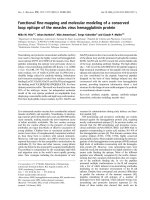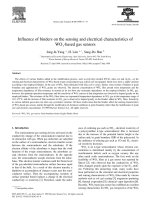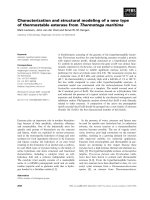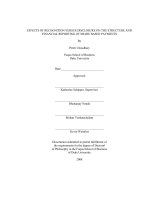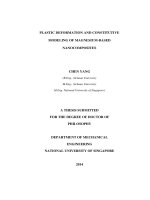Plastic deformation and constitutive modeling of magnesium based nanocomposites
Bạn đang xem bản rút gọn của tài liệu. Xem và tải ngay bản đầy đủ của tài liệu tại đây (9.1 MB, 167 trang )
PLASTIC DEFORMATION AND CONSTITUTIVE
MODELING OF MAGNESIUM-BASED
NANOCOMPOSITES
CHEN YANG
(B.Eng., Sichuan University
M.Eng., Sichuan University
M.Eng. National University of Singapore)
A THESIS SUBMITTED
FOR THE DEGREE OF DOCTOR OF
PHILOSOPHY
DEPARTMENT OF MECHANICAL
ENGINEERING
NATIONAL UNIVERSITY OF SINGAPORE
2014
Declaration
I hereby declare that this thesis
is
my original work and it has been
written by me in its entirety.
I have duly acknowledged all the sources
of
information which
have been used in the thesis.
This thesis has also not been submitted for any degree in any
university previously.
Chen Yang
2015
Acknowledgements
ii
Acknowledgements
I would like to gratefully thank Prof. Victor P.W. Shim and Prof. Manoj Gupta for
their invaluable guidance, continuous support and encouragement in this work. In
particular, I wish to express my sincere gratitude to Prof. Shim for his patience,
insightful advice and efforts in maintaining a wonderful research environment. His
serious and positive attitude on research, communication and life inspires me far
beyond this work.
I would like to thank all the members in the Impact Mechanics Laboratory.
Thanks to the laboratory officers, Mr. Jow Low Chee Wah and Mr. Alvin Goh Tiong
Lai for their technical support in experimental work. As for my friends and colleagues,
I would like to thank Dr. Guo Yangbo, Dr. Gao Guangfa, Dr. Nguyen Quy Bau, Dr.
Tan Long Bin for their kind assistance with experiments and valuable discussions on
modelling, my thanks also to Dr. Jing Lin, Dr. Ma Dongfang, Dr. Kianoosh Marandi,
Ms. Xu Juan, Dr. Habib Pouriayevali, Mr. Saeid Arabnejad Khanooki, Mr. Nader
Hamzavi, and Mr. Emmanuel Tapie for their help in matters relating to work and life
in the laboratory.
Special thanks to professors who taught courses I took, for sharing their
knowledge and time to give me a better understanding of the theories related to my
research.
I would also like to thank the National University of Singapore for providing a
research scholarship to support my pursuit of graduate studies.
Last, but by no means least, I would like to express my sincere gratitude to my
family for their love, unending care, constant support and encouragement.
Table of Contents
iii
Table of Contents
Declaration i
Acknowledgements ii
Summary vi
List of Figures viii
List of Tables xiii
Nomenclature xiv
Chapter 1 – Introduction 1
Chapter 2 – Literature Review 5
2.1 Development of magnesium based metal matrix composites 5
2.2 Deformation mechanisms in magnesium 7
2.2.1 Slip and twinning systems in magnesium 8
2.2.2 Introduction to deformation twinning 10
2.2.3 CRSS for different slip and twinning systems in magnesium 13
2.3 Mechanical behavior of magnesium and its alloys 15
2.3.1 Mechanical behavior of pure magnesium single crystals 15
2.3.2 Mechanical behavior of magnesium alloys 18
2.3.3 Mechanical behavior of magnesium alloys under dynamic
loading 23
2.4 Constitutive modeling using crystal plasticity theory 29
Chapter 3 – Experiments 32
3.1 Materials Used 32
3.2 Primary processing (DMD) 34
3.3 Hot extrusion 34
3.4 Microstructure characterization 36
3.5 Density measurement 36
3.6 X-ray diffraction studies 37
3.7 Quasi-static tension and compression tests 37
Table of Contents
iv
3.7.1 Tensile tests 37
3.7.2 Compression tests 38
3.8 Dynamic mechanical tests using Split Hopkinson Bar (SHB) Devices 40
3.8.1 Tensile tests 40
3.8.2 Compression tests 42
3.9 Fractography 42
Chapter 4 – Mechanical properties of magnesium nanocomposites under quasi-
static and dynamic loading 44
4.1 Introduction 44
4.2 Experimental results for tensile properties and discussion 45
4.2.1 Macrostructure 45
4.2.2 Microstructures 46
4.2.3 Texture change during quasi-static and dynamic tensile tests 48
4.2.4 Quasi-static tensile mechanical properties 53
4.2.5 Dynamic tensile mechanical properties 56
4.2.6 Fractography for tension tests 63
4.3 Results for compressive properties and discussion 65
4.3.1 Texture change during quasi-static and dynamic compression
tests 65
4.3.2 Quasi-static compressive mechanical properties 68
4.3.3 Dynamic compressive mechanical properties 71
4.3.4 Competition between grain size and strain rate effect on flow
stress 78
4.3.5 Fractography for compression tests 82
4.4 Conclusions 85
Chapter 5 – Constitutive modeling 87
5.1 Introduction 87
5.2 Slip and twin systems 89
Table of Contents
v
5.3 Constitutive model 92
5.3.1 Constitutive law for slip and twin 94
5.3.2 Evolution of twin volume fractions 99
5.4 Numerical implementation 101
5.4.1 Finite element model 101
5.4.2 Model validation 102
5.4.3 Calibration of material parameters for constitutive model 105
5.4.4 Initial texture in simulations 107
5.4.5 Simulation of tensile loading results and discussion 109
5.4.6 Simulation of compressive loading results and discussion 115
5.4.7 Numerical tests for three simple textures in monolithic AZ31 120
5.5 Conclusions 124
Chapter 6 – Conclusions and recommendations for future work 125
6.1 Conclusions 125
6.2 Recommendations for future work 127
Bibliography 129
Appendix A. Time-integration procedure for crystal plasticity constitutive model
148
Summary
vi
Summary
The focus of this research effort is to investigate the response of AZ31 Mg alloy
based nanocomposites to tensile and compressive plastic deformation and to develop
a crystal plasticity model to capture the essential characteristics of the behaviour
observed.
AZ31 Mg alloy, reinforced by different volume fractions of 50-nm Al
2
O
3
nanoparticles (1v%, 1.4v% and 3v%), were fabricated by a disintegrated melt
deposition technique, followed by hot extrusion. The tensile and compressive
mechanical behaviour of these materials at strain rates spanning 10
-4
to 10
3
s
-1
was
investigated. Compared to monolithic AZ31, the nanocomposites display significantly
increased yield stress and ultimate stress for both low and high rate tension, indicating
the positive influence of nanoparticles. For each type of material, the strain to failure
increases with strain rate for both tension and compression. The ductility of
nanocomposites is significantly higher than that of monolithic AZ31, by 49% and 33%
respectively for low and high rate tensile loading; this is attributed to the addition of
nanoparticles. In contrast, there is no obvious increase in ductility for the
nanocomposites subjected to compression; this difference is attributed to the
activation of {1012} 1011 tension twinning under compression. Such twinning
generates many sites for crack initiation and propagation. Consequently, the influence
of nanoparticles on ductility is diminished by the activation of tension twinning
during compressive deformation.
A rate-dependent crystal plasticity model is developed to investigate the
mechanical responses of AZ31-based nanocomposites, and implemented in
Summary
vii
ABAQUS/Explicit (2010) finite element software via a user-defined material
subroutine (VUMAT). The effect of the nanoparticles is captured by incorporating a
term describing the interaction between the nanoparticles and slip/twinning in the
hardening evolution laws for slip/twinning. The simulation results match the
experimental stress-strain curves closely, and show that the addition of nanoparticles
does not change the average relative degree of activity of slip and twinning during
deformation.
List of Figures
viii
List of Figures
Fig. 2-1 Different types of metal matrix composites [36] 6
Fig. 2-2 Hexagonal close-packed structure: a unit cell of the lattice and a hexagonal
cell showing the arragement of atoms [38]. 7
Fig. 2-3 Plastic deformation modes in a hexagonal-close packed structure: (a) Basal
a
slip systems, (b) prismatic
a
slip systems, (c) pyramidal
ca slip systems and (d) tensile twin [47]. 9
Fig. 2-4 (a) Depiction of twinning in a localized region in a crystal (b)
Crystallographic twinning elements [51] 11
Fig. 2-5 Variation of twinning shear with axial ratio. For the seven hexagonal close
packed metals, a filled symbol indicates that twinning is an active mode
[52]. 12
Fig. 2-6 Experimental values of CRSS for slip and twin modes in pure Mg single
crystals [55] 13
Fig. 2-7 Stress-strain curves for pure magnesium single crystals compressed along
seven different directions. A - G denote initial crystal orientations [60]. 16
Fig. 2-8 Temperature-dependence of the critical resolved shear stresses for basal
and prismatic slip in magnesium and titanium [62]. 18
Fig. 2-9 Stress-strain curves for pure magnesium single crystals compressed along
(a) C direction; (b) D direction [60]. 20
Fig. 2-10 Hall-Petch plots of the flow stress at 0.2% offset strain [65] 20
Fig. 2-11 Mechanical response of AZ31 for simple compression and tension at room
temperature and a constant strain rate of 10
-3
s
-1
[69]. 21
Fig. 2-12 Nominal stress-strain relations for the annealed AZ31 alloy followed by
ECAE, and the same alloy by direct extrusion [11]. 22
Fig. 2-13 Plastic flow curves for out of plane compression at various temperatures
[75]. 23
List of Figures
ix
Fig. 2-14 Compressive stress-strain response of AZ31, showing the influence of
anisotropy effect on strain rate dependence [77] 24
Fig. 2-15 Comparison of strain rate effect on stress at 5% plastic strain at (a) room
temperature and (b) elevated temperatures [79] 26
Fig. 3-1 Flow of experimental work 33
Fig. 3-2 Array of holes in AZ31 disk to contain particles 33
Fig. 3-3 Schematic diagram of disintegrated melt deposition technique [103] 35
Fig. 3-4 Quasi-static (a) Tensile and (b) compressive test specimens (unit: mm) 38
Fig. 3-5 Quasi-static tension and compression tests using an Instron 8874 universal
testing machine 39
Fig. 3-6 Geometry of specimen for dynamic tensile tests 41
Fig. 3-7 Typical stress wave recorded during dynamic tests 41
Fig. 3-8 Schematic diagram of (a) the tensile and (b) compressive SHB devices 43
Fig. 4-1 Macrographs of (a) a cast ingot and (b) an extruded rod. 45
Fig. 4-2 Optical micrographs showing grain characteristics of (a) AZ31; (b)
AZ31/1.0Al2O3; (c) AZ31/1.4Al2O3; (d) AZ31/3.0Al2O3 47
Fig. 4-3 SEM micrograph showing the nanoparticle distribution of AZ31/1.4Al
2
O
3
(a) low magnification; (b) white spots are the Al
2
O
3
nanoparticles. 48
Fig. 4-4 X-ray diffraction patterns of the samples before tests for (a) AZ31; (b)
AZ31/1.0 vol%Al
2
O
3
50
Fig. 4-5 X-ray diffraction patterns for three types of samples (after extrusion, after
quasi-static tensile tests and after dynamic tensile tests) for materials: (a)
AZ31; (b) AZ31/1.0 vol%Al
2
O
3
; (c) AZ31/1.4 vol%Al
2
O
3
; (d) AZ31/3.0
vol%Al
2
O
3
. 52
Fig. 4-6 True stress-strain curves of quasi-static tensile tests on AZ31 and its
nanocomposites at room temperature 54
List of Figures
x
Fig. 4-7 Representative fractorgraphs showing: (a) straight lines due to slip in the
basal plane of AZ31 and (b) uneven lines due to combines effect of basal
and non-basal slip in AZ31/1.0vol%Al
2
O
3
nanocomposite. 56
Fig. 4-8 True stress-strain curves of both quasi-static and dynamic tensile tests. (a)
Tension results at strain rate ~10
3
s
-1
for AZ31 and its nanocomposites; (b)
and (c) AZ31 and AZ31/1.4 vol%Al
2
O
3
tension results at three strain rates.
57
Fig. 4-9 Strain rate sensitivity for AZ31 and its nanocomposites at 4% and 10%
tensile strain. 60
Fig. 4-10 Hardening rate as a function of true strain for four materials subject to
quasi-static tension. 60
Fig. 4-11 Hardening rate as a function of true strain for four materials under
dynamic tension. 61
Fig. 4-12 Hardening rates as a function of true strain for four materials subject to
low and high strain rate tension. 61
Fig. 4-13 Fractographs of quasi-static tensile tests for AZ31 in (a) and AZ31/1.0
vol%Al
2
O
3
in (c); and dynamic tensile tests at strain rate 10
3
s
-1
for AZ31
in (b) and AZ31/1.0 vol%Al
2
O
3
(d). 64
Fig. 4-14 X-ray diffraction patterns for three types of samples (after extrusion, after
quasi-static compression tests and after dynamic compression tests) for:
(a) AZ31; (b) AZ31/1.0 vol%Al
2
O
3
; (c) AZ31/1.4 vol%Al
2
O
3
; (d)
AZ31/3.0 vol%Al
2
O
3
. 67
Fig. 4-15 The density ratio between prismatic and pyramidal planes after quasi-
static and dynamic compression tests. 68
Fig. 4-16 True stress-strain curves of quasi-static compression tests on AZ31 and its
nanocomposites at room temperature 69
Fig. 4-17 Quasi-static tension and compresion curves for the monolithic and
AZ31/1.0Al
2
O
3
71
Fig. 4-18 True stress-strain curves for dynamic compression tests at strain rates of (a)
~1700 s
-1
; (b) ~2500 s
-1
. 73
List of Figures
xi
Fig. 4-19 True stress-strain curves for quasi-static and dynamic compression at
strain rates of (a) AZ31; (b) AZ31/1.0 vol%Al
2
O
3
. 75
Fig. 4-20 True stress-strain curves for quasi-static and dynamic compression at
strain rates of (a) AZ31/1.4 vol%Al
2
O
3
; (b) AZ31/3.0 vol%Al
2
O
3
. 76
Fig. 4-21 Compressive strain rate sensitivity of AZ31 and its nanocomposites at
strains of 4% and 10%. 77
Fig. 4-22 Hall-Petch plots of compression flow stress at 2% strain at strain rates of
10
-4
and ~
3
2.5 10
s
-1
. 79
Fig. 4-23 Fractographs (1.0k × magnification): (a) quasi-static compression of AZ31;
(b) dynamic compression at a strain rate of 10
3
s
-1
for AZ31; (c) quasi-
static compression of AZ31/1.0 vol%Al
2
O
3
; (d) dynamic compression at a
strain rate of 10
3
s
-1
for AZ31/1.0 vol%Al
2
O
3
. 83
Fig. 4-24 Fractographs: (a) quasi-static compression of AZ31; (b) dynamic
compression at a strain rate of 10
3
s
-1
for AZ31; (c) quasi-static
compression of AZ31/1.0 vol%Al
2
O
3
; (d) dynamic compression at a
strain rate of 10
3
s
-1
for AZ31/1.0 vol%Al
2
O
3
. 84
Fig. 5-1 Slip and twinning modes in magnesium crystals considered in present
model: (a) basal slip; (b) prismatic slip; (c) pyramidal
a
slip; (d)
pyramidal caslip; (e) tension twining. 91
Fig. 5-2 Schematic diagram of the deformation gradient decomposition 93
Fig. 5-3 3-axis and 4-axis coordinate systems for an HCP lattice (a) original
orientation, (b) rotated orientation. 100
Fig. 5-4 The mesh and boundary conditions of the numerical model 102
Fig. 5-5 Comparison of true stress-strain curves of unixial compression (a) along
ND; (b) along RD between simulation by this work and the experimental
results and simulation presented in [158]. 103
Fig. 5-6 Comparion of (a) experimental intial texture with (b) numerical initial
texture used in this work and (c) numerical initical texture used in [158].
104
List of Figures
xii
Fig. 5-7 Comparison of
{0001}
texture evolution between experimental data and the
numerical prediction by the model in [158] and the model in this work at
different strains. 104
Fig. 5-8 Numerical initical texture for scanning along transverse direction for (a)
monolithic AZ31 and (b) the nanocomposites. 107
Fig. 5-9 Schematic diagrams of relationship between the local crystal coordinate
system and the fixed global coordinate system. 109
Fig. 5-10 Comparison of simulated and experimental true stress-strain curves for
uniaxial tension, for monolithic AZ31, AZ31/1.0% Al
2
O
3
, AZ31/1.4%
Al
2
O
3
, and AZ31/3.0% Al
2
O
3
110
Fig. 5-11 Simulation results for maximum principal stress at a true strain of 0.1 for
(a) monolithic AZ31 under tension and (b) AZ31/3.0% Al
2
O
3
under
uniaxial tension. 110
Fig. 5-12 Numerical pole figures for tensile specimens of (a) monolithic AZ31 and
(b) AZ31/1.4% Al
2
O
3
at strains of 0%, 4% and 10%. 111
Fig. 5-13 Relative degree of activation of slip and twinning in monolithic AZ31
during quasi-static tensile deformation 113
Fig. 5-14 Relative degree of activation of slip and twinning in AZ31/1.4% Al
2
O
3
during quasi- static tensile deformation 114
Fig. 5-15 Comparison of simulated and experimental true stress-strain curves for
uniaxial compression, for monolithic AZ31, AZ31/1.0% Al
2
O
3
, AZ31/1.4%
Al
2
O
3
, and AZ31/3.0% Al
2
O
3
. 116
Fig. 5-16 Numerical pole figures for compression specimens of (a) monolithic
AZ31 and (b) AZ31/1.4% Al
2
O
3
at strains of 0%, 2%, 6% and 10%. 117
Fig. 5-17 Relative amount of activation of slip and twinning in monolithic AZ31
during quasi-static compression 119
Fig. 5-18 Relative amount of activation of slip and twinning in AZ31/1.4% Al
2
O
3
during quasi-static compression 119
Fig. 5-19 Schematic diagrams of three representative textures 121
List of Figures
xiii
Fig. 5-20 Stress-strain responses for three types of texture under unixial tension and
compression. 122
Fig. 5-21 Average relative activity of slip and twin modes for three types of textures
under unixial tension and compression. 123
List of Tables
xiii
List of Tables
Table 2-1 Some physical properties of magnesium [8] 7
Table 2-2 Independent slip systems in HCP metals [48] 9
Table 4-1 Density and grain morphology of AZ31 and its nanocomposites 47
Table 4-2 XRD peak densities normalized with respect to the density of the
prismatic plane (QT denotes quasi-static tension and DT denotes dynamic
tension; the ratio corresponds to:
::
prismatic basal pyramidal
DDD
). 53
Table 4-3 Results of quasi-static tensile tests on AZ31 and its nanocomposites at
room temperature 54
Table 4-4 Fracture strain for dynamic tension and compression at strain rates of
~2.2 ×10
3
s
-1
58
Table 4-5 Increments σ in tensile flow stress of nanocomposites at a strain rate of
~1×10
-4
s
-1
, with respect to the monolithic material 62
Table 4-6 Increments σ in tensile flow stress of nanocomposites at strain rates of
~1.2×10
3
s
-1
, with respect to the monolithic material 62
Table 4-7 Results of quasi-static compression tests on AZ31 and its nanocomposites
at room temperature 69
Table 4-8 Flow stress of four materials at 2% strain for strain rates of ~2.5 × 10
3
s
-1
74
Table 4-9 Decrease in dynamic compressive flow stress with respect to quasi-static
values for nanocomposites at 2% strain for strain rates of ~2.5 × 10
3
s
-1
74
Table 4-10 Fracture strain for dynamic compression at strain rates of ~10
3
s
-1
74
Table 4-11 Parameters used to predict the reduced flow stress due to temperature
increase 81
Table 5-1 Slip and twin systems considered in the present work 91
List of Tables
xiv
Table 5-2 Elastic constants (GPa) for AZ31 at 300 K 106
Table 5-3 Parameters calibrated and used in the model 106
Table 5-4 Relative ratios of densities of three peaks for three diffraction planes based
on based on XRD results shown in Fig. 4-3 and 4-4. 108
Table 5-5 The dominant slip/twin modes for three textures under unixial tension and
compression 123
Nomenclature
xiv
Nomenclature
C
Fourth order anisotropic elasticity tensor
e
E
Elastic right Cauchy-Green tensor
*
T
Stress measure conjugate to
e
E
T
Cauchy stress tensor
F
Deformation gradient
e
F
Elastic deformation gradient
p
F
Plastic deformation gradient
L
Velocity gradient
e
L
Elastic deformation gradient
p
L
Inelastic deformation gradient
Shear rate on slip/twin planes
0
n
A unit normal on the slip/twin plane
0
m
Shearing direction on the slip/twin plane
0
S
Schmid tensor
I
Second order identity tensor
Shear stress
f
Evolution rate of twin volume fraction
r
Relative activity of a slip/twin mode
h
Hardening modulus
Chapter 1 Introduction
1
Chapter 1 – Introduction
As a result of concerns about environmental issues such as global warming, energy
usage, etc., the demand for light structural materials from the automobile, aerospace
and electronics industries continues to increase [1-3]. Magnesium alloys, as some of
the lightest structural metals with only two thirds the density of aluminium and
possessing high specific strength, have attracted much attention from many
researchers [4-9]. Magnesium’s low density is a primary characteristic that endows it
with the potential to reduce energy consumption. However, the ductility of
magnesium alloys is relatively poor, because of their hexagonal close-packed (HCP)
internal lattice structure, which significantly hinders their application in industry and
the potential to replace aluminium alloys.
Much research has been carried out to seek effective ways to improve both the
strength and ductility of Mg and its alloys. Equal-channel-angular pressing (ECAP)
techniques have been employed by some researchers to induce severe plastic
deformation in Mg and its alloys [10-12], through grain refinement. The resultant
material shows some increase in strength and ductility, but, applying ECAP to induce
significant plastic flow without premature fracture in HCP metals is difficult, because
of the strong dependence of plastic flow on the initial texture of the material.
Moreover, the unsymmetrical HCP lattice structure gives rise to anisotropy, which
decreases the formability of the material [13]. Another way to improve the properties
of Mg and its alloys is to produce metal matrix composites [14, 15]. This technology
involves adding appropriate reinforcements into Mg and its alloys. The addition of
stiffer and stronger reinforcements (ceramic or metallic) into a magnesium matrix to
Chapter 1 Introduction
2
form composites has shown some promise in increasing the modulus and strength.
However, magnesium-based composites with micro-size reinforcements display
decreased ductility [16-19]. Recent studies show that when nano-sized fillers – carbon
nanotubes, ceramic particles (Al
2
O
3
, Y
2
O
3
and ZrO
2
) – are added to Mg or AZ31 Mg
alloy, significant enhancement in both strength and ductility is achieved [20-23]. The
disintegrated melt deposition (DMD) technique, a liquid phase processing technique,
is simple and practical means of fabrication to synthesize magnesium-based metal
matrix composites, and is potentially scalable for large-scale manufacturing [24, 25].
The present work adopts the DMD method to produce magnesium-based
nanocomposites for the study undertaken.
Although there has been a lot of research, especially in recent years, on the
deformation response and constitutive modelling of magnesium alloys, e.g. AZ31 [26,
27], most of the research efforts on magnesium-based nanocomposites focus on their
synthesis. Studies on the deformation behaviour of magnesium-based nanocomposites,
which have both an HCP lattice structure and nano-particles incorporated, are few
[28-30]. Furthermore, most results in literature on mechanical characterization of
these materials are for quasi-static loading. Studies on their dynamic response in
terms of stress-strain relationships are limited [31].
The quasi-static mechanical responses of metallic materials generally differ with
their behaviour under dynamic loading. The strain rate sensitivity (SRS) for body-
centred cubic (BCC) metals is reflected in the yield stress dependence. In contrast,
SRS for face-centred cubic (FCC) metals is manifested by their strain hardening
properties [32]. An important consequence of such differences in strain rate
dependences is the influence on ductility, in terms of the maximum tensile load strain.
Ductility decreases with strain rate for BCC materials, while it increases with strain
Chapter 1 Introduction
3
rate for FCC materials; hexagonal close- packed (HCP) metals behave like either a
BCC or an FCC material [32]. Titanium and its alloys follow the BCC case, while
magnesium, zinc and cadmium follow the FCC case [32]. For magnesium and its
alloys, plastic deformation of room temperature is primarily related to slip and
twinning. Their SRS is closely linked slip and twinning activated during deformation
[33].
Dynamic loads, arising from accidental collisions or foreign-object impact, must
be considered in the design of vehicles and aircraft, and therefore, an understanding of
the dynamic behaviour of magnesium nanocomposites is crucial for their effective
usage in such applications [28, 31]. The specific objectives of this study are
summarized as follows:
(1) Fabricate AZ31-based nanocomposites which are stronger and more ductile
than monolithic AZ31;
(2) Undertake uniaxial tension and compression tests on monolithic AZ31 and its
nanocomposites in order to investigate their mechanical responses under
quasi-static (~10
-4
s
-1
) and high strain rate (~10
3
s
-1
) loading;
(3) Investigate the effects of nanoparticle addition on the mechanical properties of
the resulting nanocomposites subjected to low and high rate loading;
(4) Model the effect of nanoparticle addition into AZ31, by developing a crystal
plasticity model to describe the mechanical behaviour of the nanocomposites.
The thesis is organized as follows: in Chapter 2, a literature review is presented
and comprises four parts. The first part describes development of magnesium-based
metal matrix composites. The second introduces deformation mechanisms in
magnesium. The mechanical behaviour of magnesium single crystals and its alloys is
presented in the third part, and the last part is related to the development of
Chapter 1 Introduction
4
constitutive modelling using crystal plasticity theory. Chapter 3 describes material
preparation, metallurgical observation, and mechanical testing under quasi-static and
dynamic loading; all the experiments conducted are elucidated in detail. Chapter 4
focuses on analysis of the results. The microstructures of the materials observed using
different microscopes are presented, and the effect of strain rate and nanoparticles are
discussed. The interaction between extension twinning and nanoparticles, coupled
with the influence of strain rate and texture are also investigated. A constitutive model
based on crystal plasticity, which includes the effects of nanoparticles, is formulated
in Chapter 5. For magnesium, dislocation slip and twinning are the main deformation
mechanisms considered in this crystal plasticity model. The effect of nanoparticles is
reflected in the hardening laws for slip and twinning. The simulation results,
parameter calibration and deformation mechanisms discussed based on the results are
also presented in Chapter 5. Chapter 6 lists conclusions deduced and proposes
recommendations for future research.
Chapter 2 Literature Review
5
Chapter 2 – Literature Review
2.1 Development of magnesium based metal matrix
composites
“In the past 30 years, Metal Matrix Composites (MMC) have progressed from
primarily a laboratory enterprise with only narrow commercial significance to a
diverse and robust class of materials with numerous important application across a
number of commercial markets” [15]. Fig. 2-1 shows different types of metal matrix
composites.
Although magnesium alloys, e.g. AZ31, AZ91, and AM60, have been successfully
used in many industrial applications, their usage is still relatively less than that of
aluminium alloys [4]. This is because of certain disadvantages of magnesium alloys,
which include limited workability and strength at room temperature, poor corrosion
properties and limited high temperature properties. MMC technology provides a
potential means to improve the properties of magnesium alloys by the addition of
suitable reinforcement. Ceramic particles such as SiC, Al
2
O
3
, and B
4
C are commonly-
used reinforcement materials in a magnesium matrix [34]. These particles are in
general, of micron or submicron length. However, while the use of these
reinforcements leads to an improvement in strength, the ductility of the resulting
composites is decreased, and this restricts their formability. A possible reason is that
large ceramic particulates are prone to cracking during mechanical loading, which
leads to premature failure and low ductility [35].
Chapter 2 Literature Review
6
In recent years, some studies have shown that use of nano-sized reinforcement in
pure magnesium or its alloys, can simultaneously improve strength and ductility.
Hassan’s work [36] demonstrated that the ductility of magnesium-based MMC (pure
magnesium with a small volume fraction (0.22% ~ 2.49%) of nano-Al
2
O
3
, nano-Y
2
O
3
and nano-ZrO
2
respectively) increases significantly by 70% to 300%. At the same
time, its strength is also enhanced. Similar results have also be found by Ngyuen and
Paramsothy [25, 37].
Fig. 2-1 Different types of metal matrix composites [38]
Chapter 2 Literature Review
7
2.2 Deformation mechanisms in magnesium
Magnesium is the lightest structural metal, with a specific density of about 1.74
g/cm
3
. It is the eighth most abundant element in the earth’s crust and the third most
plentiful element dissolved in seawater [39]. Some properties of magnesium are
presented in Table 2-1. Magnesium was first isolated as a metal by the French
scientist Antoine Alexander Bussy in 1828. In 1886, commercial production of
magnesium commenced in Germany, and subsequently spread worldwide. The
amount of magnesium production increased significantly during World War II [8] .
Magnesium has a hexagonal close-packed crystal structure, as shown in Fig. 2-2.
Miller Bravais indices are used to define a coordinate system based on three basal
vectors,
1
a ,
2
a ,
3
a , and the longitudinal axis is denoted represented by , which is the
axis of hexagonal symmetry.
Table 2-1 Some physical properties of magnesium [8]
Density (g/cm
3
) Melting point (
o
C) Young’s modulus
(GPa)
Poisson ratio
1.738 650 40 0.35
Fig. 2-2 Hexagonal close-packed structure: a unit cell of the lattice and a
hexagonal cell showing the arrangement of atoms [40].
Chapter 2 Literature Review
8
2.2.1 Slip and twinning systems in magnesium
Over the past few decades, advances in dislocation theory show that the physical
mechanism of plastic deformation of crystalline material is associated with the
movement of dislocations. Various slip and twinning systems have been identified via
research over the years, to be activated during plastic deformation of magnesium [41].
Basal slip and pyramidal twinning were first reported in 1939 by Beck as the
deformation mechanism at low homologous temperatures [42]. Subsequently,
prismatic
a
slip systems were recognized as another active slip mode by Hauser
et al. [43], Reed-Hill and Robertson [44], as well as Yoshinaga and Horiuchi [45].
Following this, Obara, Yoshinaga et al. [46] and Ando and Tonda [47] identified
pyramidal ca slip as another active deformation mechanism at low homologous
temperatures. Fig. 2-3 shows the different slip and twin systems.
Based on the von Mises criterion [48], activation of five independent plastic
deformation systems are required to accommodate arbitrary plastic deformation in any
given material. For magnesium, basal slip provides only two independent slip systems.
There are also two independent slip systems for the prismatic
a
slip mode. In
total, there are four independent slip systems. To satisfy the von Mises criterion,
deformation twinning plays an important role during plastic deformation in
magnesium. Twinning can provide a deformation component in the < c > direction,
which is strongly related to the ductility of magnesium. However, the amount of
deformation resolved along the
c
direction associated with the twinning volume
was not sufficient to account for the ductility of Mg at low homologous temperatures
[49]. Pyramidal ca slip provides additional deformation component in the
c
direction. However, this type of slip has a high critical resolved shear stress


